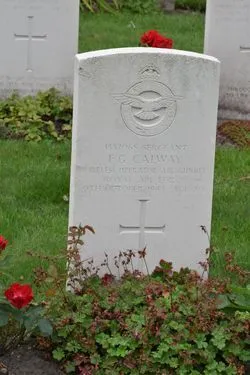Rogers, Eric (Flight Sergeant)
Killed in Action 1943-October-09


Birth Date: 1920-July-22
Born:
Parents: Son of Arthur Edward Rogers and Mary Agnes Rogers (nee Hannebury), of Spruce Grove, Edmonton, Alberta
Spouse:
Home: Vancouver, British Columbia
Enlistment:
Enlistment Date: unkown date
Service
RCAF
Unit
218 (B) Sqn- Squadron (RAF)
In Time
Base
RAF Downham Market
Rank
Flight Sergeant
Position
Pilot
Service Numbers
R/121900
Target
Temporary Burial
Remains were later exhumed from this location and reburied
Crew or Other Personnel
Stirling BK687
Mission
Stirling Mk. lll BK687
Bombing Bremen Germany 1943-October-08 to 1943-October-09
218 (B) Sqn (RAF) RAF Downham Market
119 aircraft - 95 Stirlings, 17 Halifaxes, 7 Lancasters, of 3 and 8 Groups. This was a diversionary raid on a larger scale than ever before. The bombing was scattered but this was a subsidiary aim of the operation. 3 Stirlings lost, 2.5 percent of the force. Minor Operations: 10 Mosquitos to Castrop-Rauxel, 7 to Berlin, 1 to Duren, 17 Stirlings minelaying in the River Gironde and off La Pallice, 2 OTU sorties. No Losses. Total Effort for the night: 660 sorties, 30 aircraft (4.5 percent) lost
218 Gold Coast Squadron (In Time) RAF Downham Market. Stirling III aircraft BK 687 HA-R was shot down by night fighter pilot Leutnant Hans-Heinz Augenstein of the 9/NJG 1, flying a Bf 110G from Twente airfield, the Netherlands during an operation against targets in Bremen, Germany. The Stirling crashed at Ebersdorf, Germany with the loss of the entire crew, flying their fourteenth operation
The Bomber Command War Diaries and Operational Reference book, 1939-1945 by Martin Middlebrook and Chris Everitt, page 438
From St Vith to Victory, 218 (Gold Coast) Squadron and the Campaign Against Nazi Germany by Stephen C Smith, page 184
![]() Royal Air Force Serial and Image Database
Royal Air Force Serial and Image Database
![]() Allied Losses and Incidents: All Commands
Allied Losses and Incidents: All Commands
Stirling serial: BK687

In June 1944, this Short S.29 Stirling B Mk. IV (Serial No. LK589), coded V3, RAF, was flown across the Atlantic as part of a navigation training exercise and did a tour of bases in Eastern Canada. It is shown here at Malton, Ontario. It was flown back to the UK after a two-week visit.
The Short Stirling was a British four-engined heavy bomber of the Second World War. It has the distinction of being the first four-engined bomber to be introduced into service with the Royal Air Force (RAF).
The Stirling was designed during the late 1930s by Short Brothers to conform with the requirements laid out in Air Ministry Specification B.12/36. Prior to this, the RAF had been primarily interested in developing increasingly capable twin-engined bombers but had been persuaded to investigate a prospective four-engined bomber as a result of promising foreign developments in the field. Out of the submissions made to the specification Supermarine proposed the Type 317, which was viewed as the favourite, whereas Short's submission, named the S.29, was selected as an alternative. When the preferred Type 317 had to be abandoned, the S.29, which later received the name Stirling, proceeded to production. In early 1941 the Stirling entered squadron service. During its use as a bomber pilots praised the type for its ability to out-turn enemy night fighters and its favourable handling characteristics whereas the altitude ceiling was often a subject of criticism. The Stirling had a relatively brief operational career as a bomber before being relegated to second line duties from late 1943. This was due to the increasing availability of the more capable Handley Page Halifax and Avro Lancaster, which took over the strategic bombing of Germany. Decisions by the Air Ministry on certain performance requirements (most significantly to restrict the wingspan of the aircraft to 100 feet) had played a role in limiting the Stirling's performance; the 100ft limit also affected earlier models of the Halifax (MkI & MkII) though the Lancaster never adhered to it.
During its later service, the Stirling was used for mining German ports; new and converted aircraft also flew as glider tugs and supply aircraft during the Allied invasion of Europe during 1944"“1945. In the aftermath of the Second World War, the type was rapidly withdrawn from RAF service, having been replaced in the transport role by the Avro York, a derivative of the Lancaster that had previously displaced it from the bomber role. A handful of ex-military Stirlings were rebuilt for the civil market. Wikipedia






